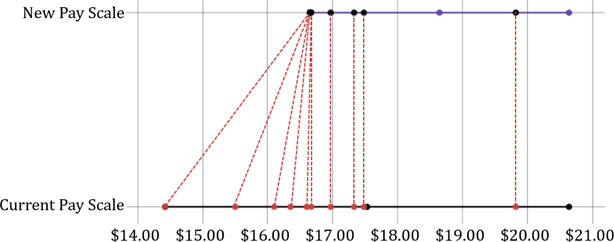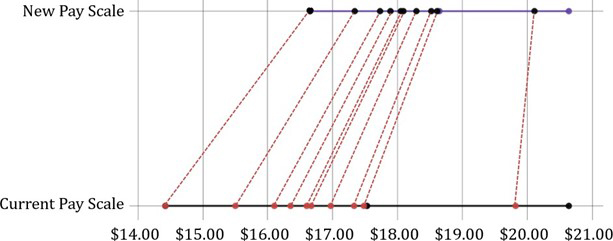Investing in Employees During an Economic Downturn: How We Implemented Our Living Wage Strategy
One decade ago, the Maricopa County Community College District committed to a $30,000 livable wage for its full-time employees. While this wage helped meet employee needs at the time, in April 2022, the district’s lowest paid full-time employees were finding it difficult to keep up with cost-of-living increases, as annual inflation reached 8.3 percent. On top of the climbing inflation rate, the organization was experiencing financial challenges with declining enrollment due to COVID-19 and other societal factors. The district’s governing board, comprised of elected officials, decided to face these challenges head on in May 2022 and respond to the highest inflationary increase in decades by raising the livable wage by 15.5 percent — from $14.42 to $16.65.
While Deputy Chief Human Resources Officer Frank Wilson and Classification and Compensation Director Michelle Keller celebrated the board’s decision, they knew that careful implementation of the livable wage strategy would be critical to preventing additional pay compression and reduced employee morale. Their concern was that the organization’s pay grade classification structure (Figure 1) was not designed for a $16.65 livable wage, and insufficient resources were available to shift the entire scale by 15 percent.

Figure 1. Lower End of the Staff Salary Scale With a $16.65 Livable Wage
Salary Structure Shift
Fixing the structure itself would be critical to implementation. The duo observed that moving employees out of pay grades 103 and 104 and resetting the scale with $16.65 minimums for pay grades 105, 106, 107 and 108 would result in a structure with sufficiently large pay ranges to appropriately place employees while maintaining the integrity of the overall salary structure (Figure 2).

Figure 2. Salary Scale Reset With $16.65 Livable Wage as Minimum for Each Pay Grade Below 109
There were 234 employees in pay grades 103 to 108, including jobs such as custodian, groundskeeper and administrative specialist. Employees in grade 108 would be mapped to the new grade 108, employees in grades 106 and 107 would be mapped to the new grade 107, employees in grade 105 would be mapped to the new grade 106, and employees in grades 103 and 104 would be mapped to the new grade 105.
Some of these 234 employees were already earning slightly more than $16.65 per hour, and raising newly-hired coworkers earning $14.42 per hour to $16.65 per hour without simultaneously adjusting the pay rates of the higher-paid incumbents would create pay compression and negatively affect employee morale. Dr. Wilson, a former mathematics professor, drew upon his mathematical foundation to devise an efficient, cost-effective strategy to map current pay rates to appropriate pay rates in the new scale that would be easily administered and understood.
“In mathematical terms, I used the concept of function transformations to determine the function that would map the old pay rates to the new pay rates. In layperson terms, I designed a mathematical model to efficiently and cost-effectively adjust the pay rates of all incumbents so that they would maintain their relative position to each other even as the lowest rates were brought up from $14.42 per hour to $16.65 per hour,” explained Dr. Wilson.
Although Wilson and Keller were comfortable with the mathematical formula, they knew that many of the affected employees would need a less mathematical explanation of the model.
Table 1 and Figure 3 show the pay compression that would have occurred if the higher rates had not been simultaneously adjusted as the lowest rates were brought up from $14.42 to $16.65.
| Current Pay Rate | New Pay Rate |
| $14.42 | $16.65 |
| $15.50 | $16.65 |
| $16.10 | $16.65 |
| $16.35 | $16.65 |
| $16.60 | $16.65 |
| $16.67 | $16.67 |
| $16.97 | $16.97 |
| $17.33 | $17.33 |
| $17.48 | $17.48 |
| $19.82 | $19.82 |
Table 1. Pay Compression Resulting From Wage Adjustment Without Preserving Relative Pay Position

Figure 3. Pay Compression Resulting From Wage Adjustment Without Preserving Relative Pay Position
Table 2 and Figure 4 show how Wilson’s mapping strategy prevented pay compression by preserving the relative pay position of employees as they transitioned to the new scale. The new pay rate was determined by the formula:

Example:

| Current Pay Rate | New Pay Rate |
| $14.42 | $16.65 |
| $15.50 | $17.34 |
| $16.10 | $17.73 |
| $16.35 | $17.89 |
| $16.60 | $18.05 |
| $16.67 | $18.09 |
| $16.97 | $18.29 |
| $17.33 | $18.52 |
| $17.48 | $18.61 |
| $19.82 | $20.11 |
Table 2. Pay Compression Avoided By Preserving Relative Pay Position

Figure 4. Pay Compression Avoided By Preserving Relative Pay Position
Communicating the Change
Although Wilson and Keller were comfortable with the mathematical formula, they knew that many of the affected employees would need a less mathematical explanation of the model. Recognizing the importance of communicating the change clearly to affected employees, Wilson and Keller engaged with change management expert Megan Tormey, director of client services. Together they strategized how to communicate the change to the 234 employees, their supervisors and the local HR teams at each of the district’s 10 colleges. Staff employee group leaders were also informed of the change and invited to provide input for the planned communication strategy. Based on their input, the communications plan took a 3-step approach:
- Each affected employee was sent an individualized email informing them of the change in pay grade, the former pay rate and the new pay rate. Providing communications to the diverse employee population with language translation was critical.
- Two all-employee town halls were held to explain the changes and answer questions.
- Recordings of the town halls were closed captioned and made available to all employee.
Momentum for the Future
Keller and Wilson readily admit the livable wage adjustment didn’t solve all of the organization’s compensation challenges and that much work remains.
“We are committed to investing in our employees, and celebrate incremental gains in making their lives better. With the continued engagement of our Compensation Advisory Committee, we anticipate many more improvements in our compensation program in the coming years, including continued improvements to the livable wage,” said Dr. Wilson.
The livable wage initiative is just one part of the district’s strategic compensation plan spanning the next five years, which focuses on progressive pay practices, internal pay equity and market alignment. Dr. Georgetta Kelly, chief human resources officer and the visionary behind the multi-year plan, said, “The district’s employees are our most valued resource, and caring for them through the right compensation practices and structures matters.”
About the authors: Dr. Frank Wilson, SHRM-SCP, is deputy chief human resources officer; Michelle Keller, SPHR, SHRM-SCP, CCP, is classification and compensation director; Megan Tormey is director of client services; and Dr. Georgetta Kelly is chief human resources officer, all of Maricopa County Community Colleges.
